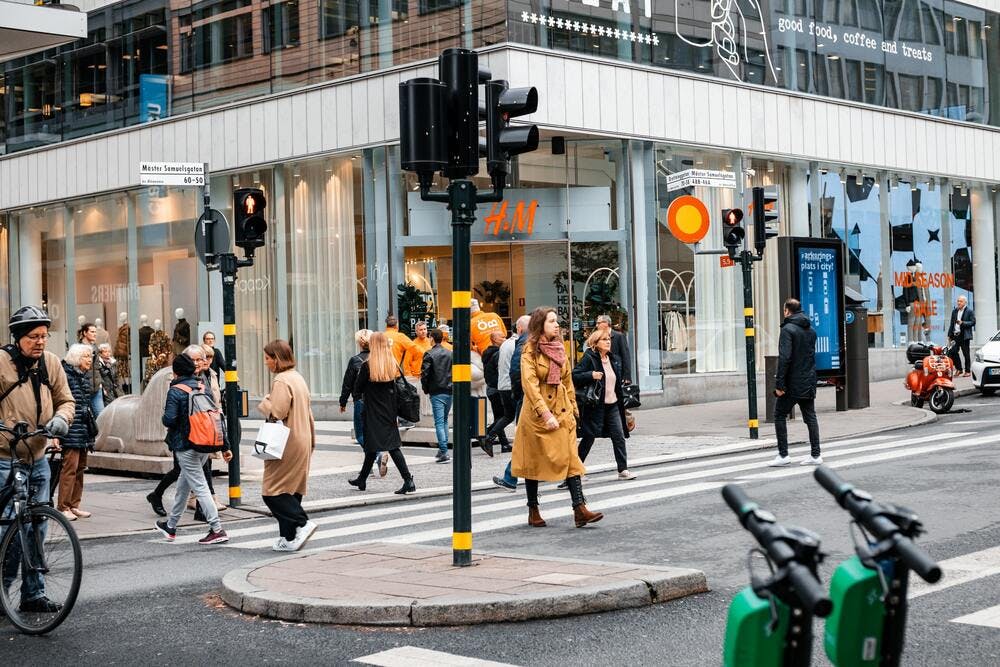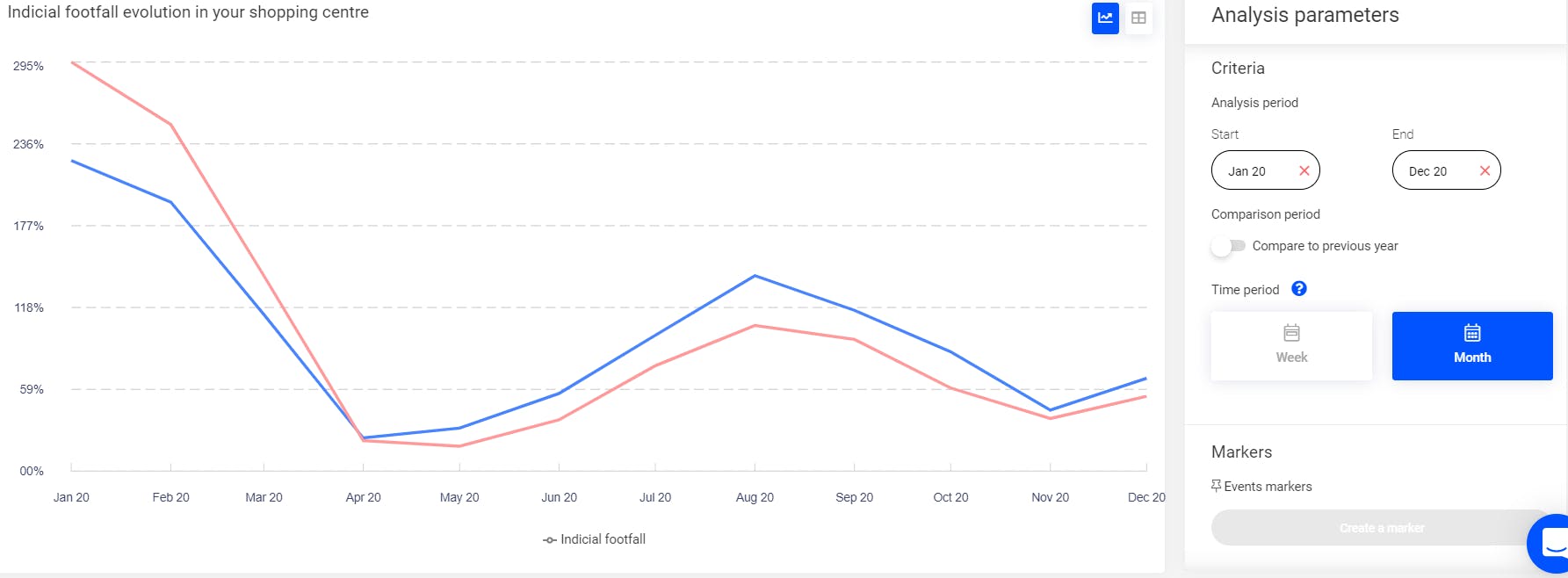How to use footfall to improve commercial performance?

Today, every retail and commercial real estate actor must consider footfall data. Studying foot data in front of a store provides strong consumer insights allowing you to understand your business better. Physical counters are no longer the only way to receive footfall traffic .Today, commercial actors can rely on mobile data, allowing far more precise localization. Thanks to this data, you can observe real catchment areas, market penetration rates, and even cannibalisation rates. In this article, we will:
- Define footfall
- Introduce how to use footfall analytics (for retailers and Commercial Real Estate players)
- Introduce measurement techniques for footfall
- Give insights on the use of MyTraffic platform to analyse footfall data
What is footfall analysis?
Footfall measurement is the action of counting the number of people visiting a store or a commercial area at a given time. It is a key metric to optimise your business’s performance.
Traditionally, this metric was linked to physical, in-store counting devices, however now it is measured thanks to mobile GPS data, ultimately increasing the beneficial use cases of this data.
Measuring footfall is an essential step to evaluate or to improve your retail stores or shopping centres’ performance, and you can even combine it to sociodemographic data. By doing so, you will obtain strong insights about who the people passing through your shop are.
How can footfall analytics helps you to optimise your retail performance?
There’s a multitude of use cases when it comes to footfall analytics. Whether you are looking to:
- Develop your retail network or retail park
- Evaluate your in-store and communication performance
- Improve customer experience inside your stores
For Retailers:
Find the best locations for your future stores
As a brand, you might want to develop your retail network. Knowing the footfall in front of specific addresses, or inside commercial areas, allows you to build strong data-driven development strategies. You can for example:
- Get to know the traffic variation and key consumption moments of an address
- Validate a lease opportunity
- Negotiate rent
That will lead you to draw an efficient expansion plan by choosing the best areas to develop.
Find out how to use location intelligence to build your market expansion strategy by clicking here.
Better understand your in-store performance
Following footfall evolution in front of your stores over time allows you to have a clear view of the actual economic situation of your retail network. You can for example:
- Measure the exposure to pedestrian flow of your shopping window, week after week.
- Compare footfall in front of your store to your turnover (is the problem coming from internal or external factors?).
- Rank your shops according to their captation rate.
This data helps you to manage your stores. By knowing when to close one according to a low traffic for example. You can also compare foot traffic in time, to evaluate the impact of your marketing campaigns.
Improve customer experience in your stores
As a retailer, you can use footfall analytics to optimise the management of your stores’ resources. By knowing how much people pass in front of your shop’s store, you can then:
- Adapt schedule to the actual traffic.
- Adapt the number of your staff to the actual traffic.
- Measure the correlation between your turnover and attendance level.
For Real Estate players:
Increase your Real Estate Asset valuation
As a property company, measuring the footfall inside your shopping centre or in a shopping area allows you to:
- Value a vacant property
- Provide quantitative metrics to prospective tenant
- Validate a new asset opportunity
- Justify an asset’s value
Knowing the accurate footfall on your commercial real estate asset gives you the opportunity to increase its value. Discover 5 tips to do so by clicking here
Have an accurate vision on the value of your asset
Knowing the footfall fluctuation inside a shopping centre gives you insights about the actual value of your assets, enabling you to:
- Value your location by showing a rise in the address's footfall.
- Re-evaluate your rents on time.
- Watch over your assets park.
Overall, this data allows you to follow your portfolio's performance and dispose of assets at the optimal time.
Improve the customer journey in your shopping centres and retail parks
As a Shopping Centre owner or director, you can better understand the shopper experience by using footfall analytics. You can use these analyses to optimise the customer journey or to better use your means. For instance, you might:
- Adapt the stores’ implantation according to the actual visitors’ flow.
- Adapt the number of your staff to the existing foot traffic.
- Adjust your opening time.
Constructing the best customer experience based on accurate data is the best way to create customer loyalty, and to maintain a strong relationship with your visitors.
Are you working in retail or commercial real estate? Do you want to know more about the footfall data near your commercial premises? Contact us by clicking here.
How is footfall data gathered?
Traditionally, footfall was measured through people counters, installed at the door in retail stores, and in strategic spots throughout shopping centers.
Thanks to the increasing use of smartphones and geolocalised data, foot data is no longer only measured when people enter a store or a shopping center. This data is now accessible when people are simply walking by a specific address, or when they enter a defined area (like a commercial area or a shopping center).
Of course, this data is acquired with the consent of consumers. It is anonymous and held for a short period of time.
This type of data collection allows companies to not only count the number of people going into their store, but also to have insights on things like their catchment area or cannibalisation rate.
Mytraffic and footfall analysis
Mytraffic offers a geomarketing solution, gathering footfall data from 7 European countries. We centralise this data on our platform, where you can find both quantitative and qualitative footfall analysis insights.
Quantitative insights
- You can analyse footfall for specific addresses, shopping centres and commercial areas (the last two are determined on demand).
- You can observe average footfall to understand the attendance level at specific times (week, days or hours).
- You can also see dynamic footfall, to keep a track of the footfall in time and evaluate the results of your actions.
Example: footfall evolution for 2 London shopping centres in 2020:
We can clearly see here the impact of the quarantine on the traffic inside shopping centres. We can also observe that the shopping centre represented in blue is recovering faster after the quarantines than the one in red.
Qualitative insights
On our platform, you also have access to insights regarding who your consumers are.
- You can have a look on the typical demographic profile of the visitors of a commercial place.
- You can also assess the real catchment area of a commercial premise and know your penetration rate in this area (find all you need to know about commercial catchment areas by clicking here).
- Finally, you also have access to the foot data of your competitors, giving you insights about the cannibalisation of your commercial places.
Example: Demographic profile of a shopping centre, based on where do people come from and the public data available in these areas.
You can compare this data for two time periods to see if the profile of your visitors evolves over time. This analysis is also available for specific addresses.
What to remember about footfall analysis?
What is footfall?
It is the measurement of how many people visit a store or a commercial area at a given time.
How is it measured?
Thanks to mobile localisation data, counting people passing by a specific address or commercial area. This data is aggregated with local public data, providing strong consumers insights.
How to use it?
- In the Retail Industry: to optimise your development strategy, evaluate the impact of your marketing and commercial actions, optimise your retail park’s management, and to improve the in-store customer experience.
- In the Commercial Real Estate Industry: to validate new assets, value vacant property, follow your portfolio’s performance, negotiate rent, watch-over your asset park, and better manage your shopping centre/retail park.
Why choose Mytraffic for your footfall analysis?
-
A centralised platform, gathering footfall data from 7 European countries.
-
Quantitative insights, giving you the opportunity to estimate the opportunity of a location, and to evaluate the impact of your actions.
-
Qualitative insights, allowing you to understand more about your visitors and your competitors.
Learn more about your footfall and optimise your performances. Get a demo of Mytraffic


